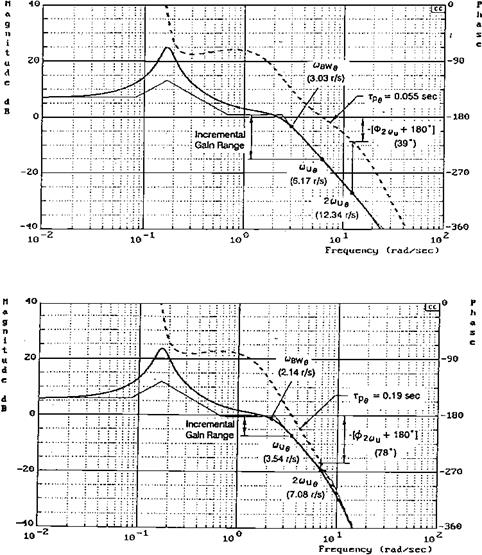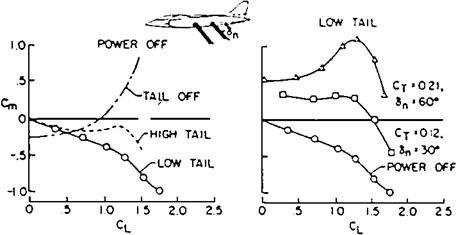Irreversible Powered Controls
An irreversible power actuator for aerodynamic control surfaces is in principle much simpler than hydraulic control boost. There is no force balancing linkage between the pilot and the hydraulic cylinder to be designed. Irreversible powered controls are classic closed loops in which force or torque is applied until a feedback signal cancels the input signal. They are called irreversible because aerodynamic hinge moments have no effect on their positions.
An easily comprehended irreversible power control unit is that in which the control valve body ishard-mounted to the actuation or power cylinder. Pilot control movement or electrical signals move the control valve stem off center, opening ports to the high pressure, or supply hydraulic fluid and low pressure, or sump hydraulic fluid. Piping delivers high-pressure fluid to one side of the piston and low-pressure fluid to the other. The piston rod is anchored to structure and the power cylinder to the control surface. When the power cylinder moves with respect to structure in response to the unbalanced pressure it carries the control valve
body along with it. This centers the control valve around the displaced stem, stopping the motion. The airplane’s control surface has been carried to a new position, following up the input to the control valve in a closed-loop manner.
The first irreversible power controls are believed to have been used on the Northrop XB-35 and YB-49 flying wing airplanes. Irreversibility was essential for these airplanes because of the large up-floating elevon hinge moment at high angles of attack, as the stall was approached. This was unstable in the sense that pilot aft-yoke motion to increase the angle of attack would suddenly be augmented by the elevon’s own up-deflection. One of the N9M flying scale models of the Northrop flying wings was lost due to elevon up-float (Sears, 1987). The YB-49’s irreversible actuators held the elevons in the precise position called for by pilot yoke position, eliminating up-float. Other early applications of irreversible power controls were to the de Havilland Comet; the English Electric Lightning P1.A, which first flew in 1954; and the AVRO Canada CF-105 Arrow, which first flew in 1958.
Howard (2000) believes that the Comet application of irreversible powered controls was the first to a passenger jet. The U. K. Air Registration Board “made the key decision to accept that a hydraulic piston could not jam in its cylinder, a vital factor necessary to ensure the failure-survivability of parallel multiple-power control connections to single surfaces.”
While irreversible power controls are simple in principle, it was several years before they could be used routinely on airplanes. The high powers and bandwidths associated with irreversible power controls, as compared with earlier boosted controls, led to system limit cycling and instabilities involving support structures and oil compressibility. These problems were encountered and solved in an ad hoc manner by mechanical controls engineer T. A. Feeney for the Northrop flying wings on a ground mockup of the airframe and its control system, called an iron bird. An adequate theory was needed for power control limit cycle instability, to explain the roots of the problem. This was presented by D. T McRuer at a symposium in 1949 and subsequently published (Bureau of Aeronautics, 1953).
The post-World War II history of gradual improvements in the design of irreversible power controls is traced by Robert H. Maskrey and W. J. Thayer (1978). They found that Tinsley in England patented the first two-stage electromechanical valve in 1946. Shortly afterwards, R. E. Bayer, B. A. Johnson, and L. Schmid improved on the Tinsley design with direct mechanical feedback from the second-stage valve output back to the first stage.
Engineers at the MIT Dynamic Analysis and Controls Laboratory added two improvements to the two-stage valve. The first was the use in the first stage of a true torque motor instead of a solenoid. The second improvement was electrical feedback of the second-stage valve position. In 1950, W. C. Moog, Jr., developed the first two-stage servovalve using a frictionless first-stage actuator, a flapper or vane. Valve bandwidths of up to 100 cycles per second could be attained. The next significant advance was mechanical force feedback in a two-stage servovalve, pioneered by T. H. Carson, in 1953. The main trends after that were toward redundancy and integration with electrical commands from both the pilot and stability augmentation computers.
In general, satisfactory irreversible power control designs require attention to many details, as described by Glenn (1963). In addition to the limit cycling referred to previously, these include minimum increment of control, position and time lags, surface positioning accuracy, flexibility, springback, hysteresis, and irreversibility in the face of external forces.













